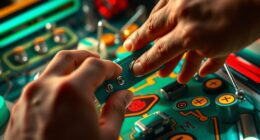PONG’s creation in 1972 revolutionized gaming with its simple, addictive gameplay that sparked arcade culture. As early arcade machines relied on coin-operated systems, issues like coin jams soon emerged—caused by worn parts, misalignments, or debris—disrupting gameplay. These mechanical challenges taught operators the importance of maintenance and durability. If you stick around, you’ll uncover more about how PONG’s innovation paved the way for future technology and the lessons learned from its early mechanical hurdles.
Key Takeaways
- PONG, launched in 1972, was the first commercially successful arcade video game, revolutionizing gaming and social interaction.
- Coin jams in vintage arcade machines like PONG occurred due to worn parts, misaligned components, or debris in coin pathways.
- Early arcade machines relied on mechanical coin mechanisms susceptible to jams, causing gameplay disruptions and maintenance issues.
- The first coin jam in arcade history highlighted the importance of durable design and regular maintenance for smooth operation.
- PONG’s legacy emphasizes the need for reliable hardware and upkeep to preserve its historical impact and gameplay experience.
The Birth of PONG and Its Impact on Gaming

PONG revolutionized the gaming world when it was first introduced in 1972, capturing the imagination of players and developers alike. Its simple yet addictive gameplay sparked a wave of digital nostalgia, reminding you of the early days of interactive entertainment. As one of the first arcade games, PONG marked a significant point in the gameplay evolution, transforming how people experienced competition and leisure. You might not realize it, but this game laid the groundwork for future innovations in game design, fostering a culture of innovation and creativity. Its straightforward mechanics made gaming accessible to everyone, setting the stage for the rapid growth of the arcade scene and inspiring countless developers to push boundaries. The game’s influence can also be seen in the rise of generative AI techniques, which continue to shape modern digital entertainment. PONG’s impact is still felt today, shaping the way you interact with digital entertainment.
How PONG Changed the Arcade Scene

The introduction of PONG transformed arcades from simple amusement venues into bustling centers of competition and social interaction. Suddenly, players gathered to test their skills, sparking a new culture around arcade gaming. This shift paved the way for virtual tournaments, where players competed across distances, expanding the arcade community beyond physical locations. As technology advanced, arcades began experimenting with augmented reality, blending digital gameplay with real-world environments. This innovation kept arcade scenes fresh and exciting, drawing in new audiences and maintaining their relevance amidst emerging home consoles. PONG’s success proved that arcade games could foster social bonds and competitive spirit, transforming arcades into lively hubs where technology and entertainment intersected, shaping the future of gaming culture.
The Technical Design Behind PONG
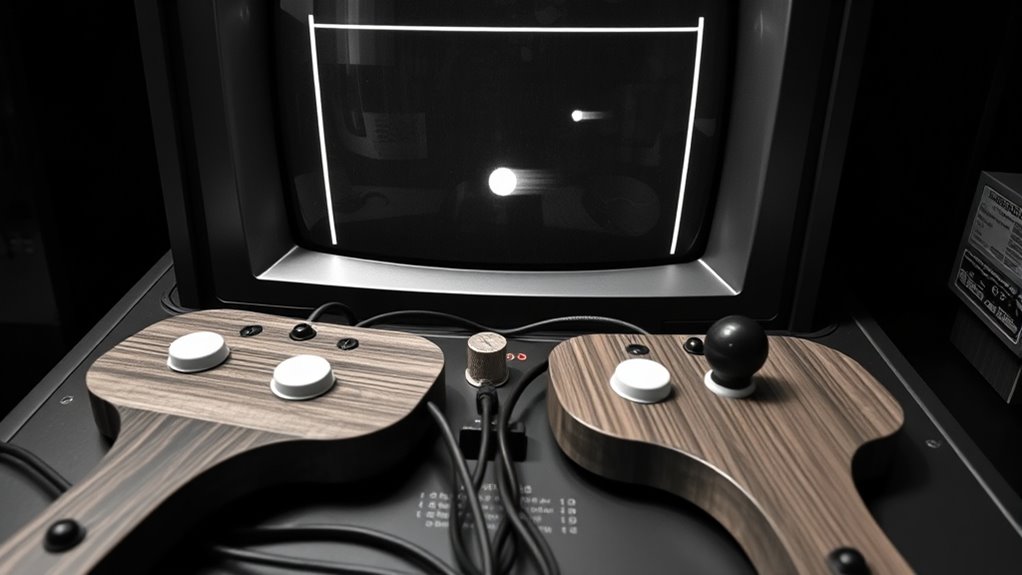
At its core, the technical design of PONG relied on simple yet effective electronic components that could be assembled with basic knowledge of circuitry. The hardware limitations of early electronics meant designers had to optimize for minimal parts and straightforward connections. The core components included oscillators, timers, and flip-flops to generate and process signals. Signal synchronization was vital to ensure smooth gameplay, so timing circuits kept the ball’s movement and paddle responses aligned. These circuits had to handle limited power and component tolerances, which often caused timing issues or signal drift. Despite these constraints, the design managed to produce a responsive game experience. The clever use of basic electronics created a reliable, engaging arcade game that laid the foundation for future video game technology. Additionally, understanding power delivery was crucial for ensuring consistent operation of the hardware components.
The Emergence of Coin-Operated Machines
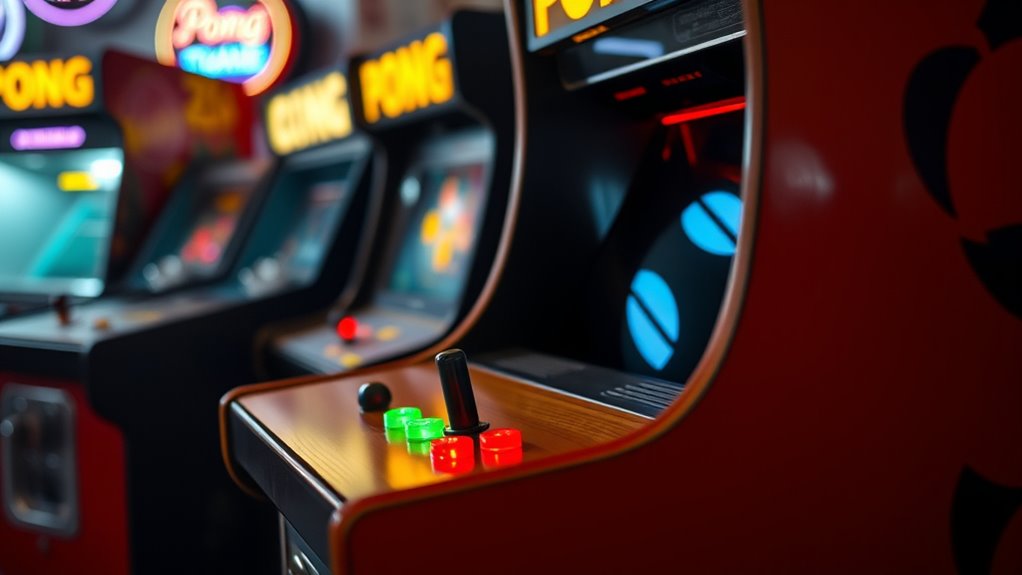
You’ve probably seen coin-operated machines everywhere, but their origins go back to simple devices designed to entertain and automate. Early innovations transformed these machines into arcade staples, revolutionizing how people played and paid for entertainment. This shift had a huge impact on the entertainment industry, paving the way for today’s gaming and amusement industries.
Origins of Coin-Operated Devices
Coin-operated devices began emerging in the late 19th century as innovative solutions to automate entertainment and convenience. You’d find coin mechanisms used to control access, making machines operate only when coins or tokens are inserted. These early systems aimed to streamline operations and reduce theft. Token systems also gained popularity, replacing coins with specially issued tokens that could be reused across machines or venues. This approach simplified transactions and encouraged repeat use. You might notice that these innovations made machines more reliable and easier to maintain. The development of electric coin mechanisms further enhanced the efficiency and security of these devices. As a result, coin-operated devices became common in arcades, laundries, and vending areas. These foundational technologies set the stage for more advanced entertainment machines, including arcade games like PONG, which relied on similar coin and token systems for operation.
Early Arcade Innovations
As coin mechanisms became more reliable and widespread in various settings, entrepreneurs and inventors saw new opportunities to create dedicated entertainment machines for public spaces. These early arcade innovations sparked a wave of vintage nostalgia, as people flocked to machines that offered simple yet addictive gameplay. The evolution of gameplay became more sophisticated, with machine designers experimenting with new mechanics to attract players. You’d find these machines popping up in arcades, restaurants, and amusement halls, transforming public entertainment. The desire for quick, accessible fun drove rapid development in coin-operated technology. This era laid the groundwork for future gaming innovations, making coin machines a staple of social interaction and casual amusement. The emergence of these early arcade innovations marked a pivotal moment in stinging bee entertainment history.
Impact on Entertainment Industries
The emergence of coin-operated machines revolutionized the entertainment industry by making games and amusement accessible to a broader audience. These machines sparked a boom in arcade gaming, drawing crowds and creating shared social experiences. As technology advanced, virtual reality began to redefine immersion, offering more engaging and realistic gameplay. Meanwhile, mobile gaming expanded the reach beyond arcades, allowing people to enjoy games anytime, anywhere. This shift influenced how entertainment industries develop content, blending physical and digital experiences. Coin-operated machines laid the groundwork for today’s diverse gaming landscape, from virtual reality arcades to mobile apps. Additionally, the development of Glycolic Acid Benefits for Skin reflects how innovations continue to shape entertainment and lifestyle trends. You now see their legacy in how entertainment continues to evolve, merging classic arcade concepts with cutting-edge technology to captivate new generations.
The First Coin Jam: What Went Wrong?
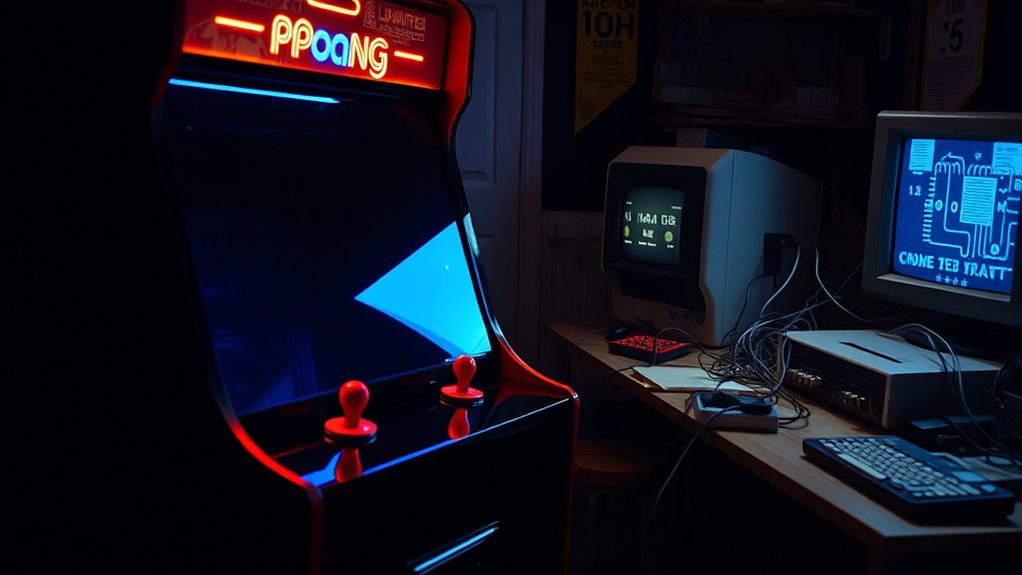
What caused the first coin jam in early arcade machines? It often resulted from design flaws or worn components that couldn’t handle frequent use. As arcade machines gained popularity, players’ excitement sometimes led to coins sticking or jamming inside. This was frustrating, especially for collectors of vintage collectibles who valued authentic experiences. To illustrate, here’s a quick look at common causes:
| Cause | Effect | Solution |
|---|---|---|
| Worn coin mechanisms | Coins get stuck | Regular maintenance |
| Poorly aligned parts | Coins jam or eject improperly | Improved calibration |
| Dust and debris | Blockages inside coin paths | Cleaning routines |
| Design flaws | Coins get stuck in loops | Better engineering |
| Excessive force | Damage to components | Player education |
Additionally, material fatigue in coin mechanisms over time can lead to increased jamming issues, emphasizing the importance of durable design and regular inspections. This chaos interrupted player nostalgia, reminding everyone why smooth operation matters in vintage collectibles.
Challenges Faced by Early Arcade Operators

As an arcade operator, you had to deal with frequent coin jams that disrupted gameplay and frustrated customers. Maintenance tasks were constant, demanding quick fixes to keep machines running smoothly. These challenges tested your ability to manage equipment and keep the arcade profitable. Additionally, understanding the importance of projector image quality helped in setting up displays that attracted customers and enhanced their gaming experience.
Coin Jam Troubles
Early arcade operators faced persistent problems with coin jams that disrupted gameplay and frustrated players. These jams often stemmed from poor coin design or misaligned coin paths, making it difficult for players to start or continue games smoothly. Coin jams also damaged the vintage memorabilia associated with classic arcade machines, diminishing their value and appeal. To combat these issues, operators had to carefully inspect and adjust the coin mechanisms regularly, which added to maintenance efforts. Poor game design, like overly tight coin paths or insufficient clearance, contributed directly to these jams. As a result, coin jams not only slowed operation but also affected the overall experience, highlighting the importance of thoughtful game design and durable coin mechanisms in early arcade machines. Additionally, Honda Tuning concepts such as precise tuning and component durability can be metaphorically applied to improve the reliability of coin mechanisms and reduce the frequency of jams.
Maintenance Challenges
Maintaining vintage arcade machines was a constant challenge for operators, who had to stay vigilant to keep them running smoothly. These vintage machinery often experienced wear and tear, requiring frequent repairs and adjustments. Ensuring the user interface remained accessible and engaging was crucial, but over time, components like buttons and screens would degrade, affecting gameplay. You had to be familiar with the inner workings of each machine, often troubleshooting electrical issues or replacing parts that wore out quickly. Coin jams, for example, could halt game flow entirely, demanding quick fixes. Keeping machines operational meant balancing technical knowledge with quick thinking, all while maintaining the game’s appeal for players. Additionally, understanding the internal mechanisms of arcade machines was essential for efficient repairs and troubleshooting. This ongoing maintenance was essential to sustain the popularity of arcade games in their early days.
Lessons Learned From the Coin Jam Phenomenon
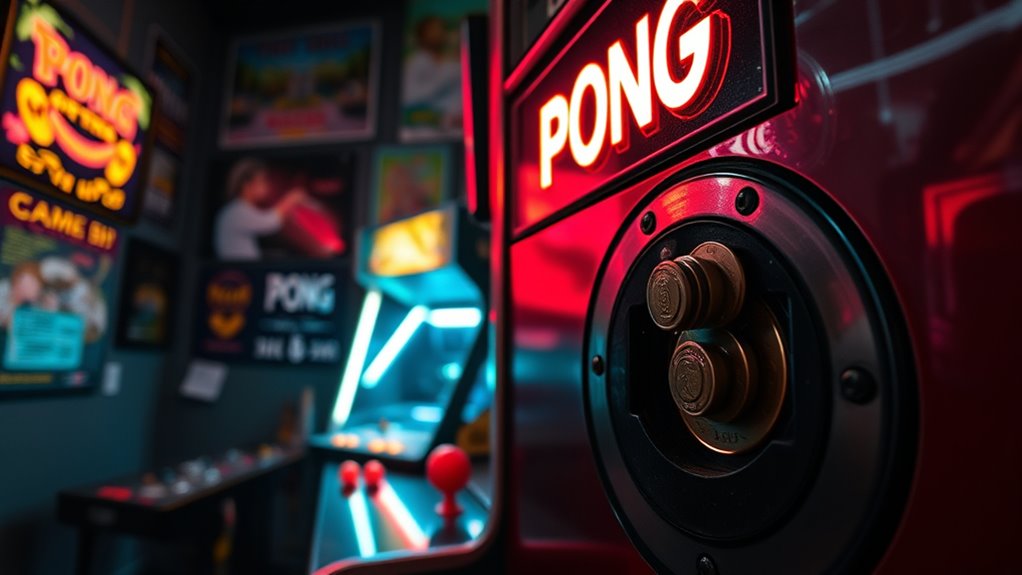
The Coin Jam phenomenon offers valuable lessons about the importance of patience, persistence, and innovative problem-solving. It highlights that even in the age of digital nostalgia, mechanical failures can still halt progress. You learn that rushing to fix issues often leads to more setbacks, so taking time to understand the root cause is vital. The event shows that troubleshooting requires creative thinking, especially when traditional solutions don’t work. Coin jams reveal how small mechanical issues can cause big disruptions, reminding you to build systems that are resilient and easy to maintain. Ultimately, this phenomenon teaches you to stay calm under pressure, adapt your approach, and view challenges as opportunities to improve both technology and your problem-solving skills.
The Legacy of PONG and Its Technical Hurdles
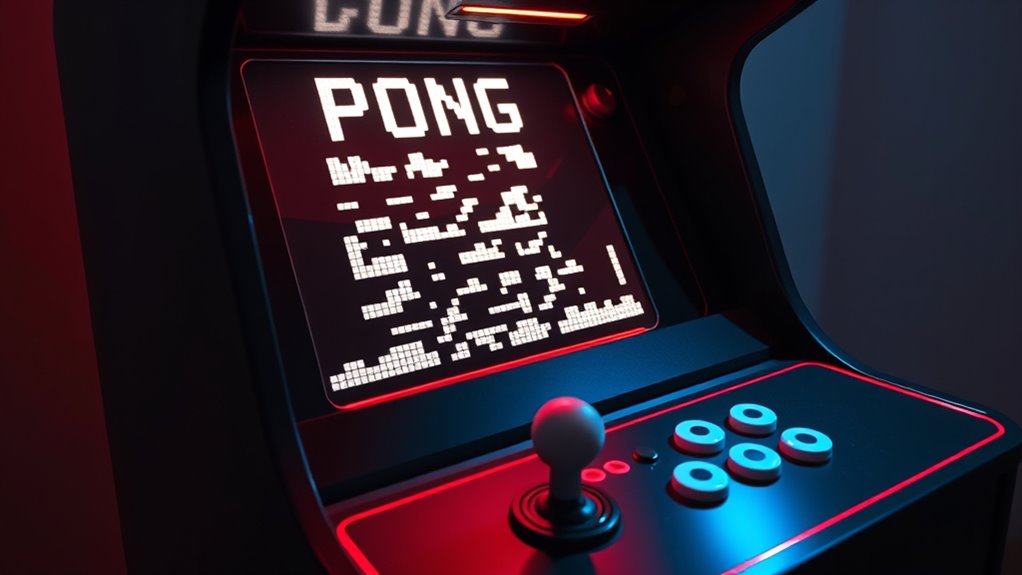
PONG’s enduring legacy stems from its role as a pioneer in video game technology, yet it also confronted significant technical hurdles that shaped its development. These challenges fueled hardware evolution, pushing engineers to improve responsiveness and reliability. As you experience digital nostalgia today, you can appreciate how PONG laid the groundwork for future gaming innovations. Its simple design inspired rapid advancements in graphics, circuitry, and processing power, enabling more complex games. Overcoming technical hurdles was essential for its success, proving that innovation often requires perseverance. Your appreciation for modern gaming owes much to PONG’s early struggles, which highlighted the importance of hardware improvements. This legacy endures, reminding you of how technical hurdles in the past shaped the vibrant gaming landscape you enjoy today.
Frequently Asked Questions
How Did PONG Influence Future Video Game Development?
You see, Pong shaped future video game development by proving simple gameplay mechanics could attract huge audiences. It pushed hardware evolution, inspiring developers to create more advanced systems. Its success showed that engaging gameplay mattered more than complex graphics, influencing game design. As a result, future games built on these fundamentals, evolving gameplay mechanics and hardware, leading to the diverse, immersive gaming experiences you enjoy today.
What Were the Main Technological Innovations in Pong’S Design?
Imagine a digital symphony where simple parts compose a game. In PONG’s design, the main innovations include a coin mechanism that made arcade play possible and electrical circuitry that powered its gameplay. These innovations transformed gaming into an accessible, coin-operated experience, setting the stage for future technological advancements. You see how basic components can create an engaging, enduring game, shaping the foundation of modern video gaming.
Why Did Coin Jams Become More Common Over Time?
You might notice coin jams becoming more common over time because the coin mechanism faces increased wear and tear, leading to frequent blockages. As the machines age, maintenance challenges grow, making it harder to keep the coin pathways clear. Dirt, debris, or misaligned coins can cause jams, and without proper upkeep, these issues happen more often, disrupting gameplay and requiring repairs.
How Did Arcade Operators Respond to Recurring Coin Jams?
You might think arcade operators just ignored coin jams, but they actively responded. They improved coin mechanisms and developed better maintenance procedures to reduce jams and keep machines running smoothly. By regularly inspecting and cleaning coin paths, they minimized downtime, ensuring players could keep playing without frustration. These proactive steps helped operators maintain revenue and enhanced the overall experience, demonstrating their commitment to keeping the coin-operated arcade business thriving.
What Safety Measures Were Implemented After Early Coin Machine Failures?
After early coin machine failures, safety measures focused on improving the coin mechanism and maintenance procedures. You’re likely to see better-designed coin mechanisms that prevent jams, reducing the risk of damage or injury. Regular maintenance procedures became standard, ensuring that operators checked and cleaned the coin mechanism frequently. These steps made machines safer for users and easier to service, ultimately enhancing reliability and safety in arcade environments.
Conclusion
You’ve seen how PONG revolutionized gaming and sparked a coin-operated craze. That first coin jam was like a storm in a teacup, exposing early tech flaws and pushing innovators to improve. It’s a reminder that even great progress faces bumps along the road. Just as PONG laid the foundation for modern gaming, those challenges fueled the fire for future innovation, proving that setbacks are just stepping stones on the path to greatness.







